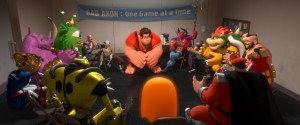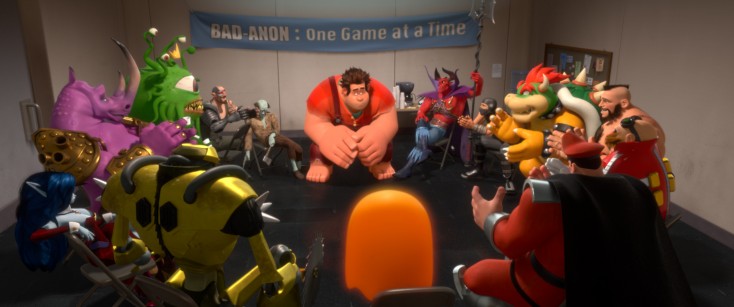
RALPH (voice of John C. Reilly) amongst other video game bad guys in “WRECK-IT RALPH.” ©2012 Disney. All Rights Reserved.
By ANGELA DAWSON
Front Row Features
HOLLYWOOD—John C. Reilly is a thoroughly committed actor—even when he is only voicing an animated character as he does in Disney’s “Wreck-It Ralph.”
While some actors regard doing voiceover animation as something akin to going on vacation, Reilly threw himself into the film.
As Ralph, Reilly is a nine-foot tall giant with large hands that he uses to demolish a brick apartment building day after day in an arcade game. His foil is Fix-It Felix Jr., who repairs the mess that Ralph creates and gains the admiration of the building’s grateful residents. The game, after all, is called “Fix-It Felix Jr.”
After 30 years of destruction, Ralph decides he no longer wants to be the bad guy. He wants to be the adored hero. The problem is he has to leave his game and enter a different one in order to win a hero’s medal. Yet he manages only to wreck havoc in a neighboring military siege arcade game, run by a tough warrior, Sgt. Calhoun (voiced by “Glee’s” Jane Lynch), and winds up crash landing in a different game—the cutely named “Sugar Rush.” There he meets a spunky little girl named Vanellope von Schweetz, better known in her land as “glitch,” because there’s a mistake in her program.
Vanellope wants nothing more than to be a racecar driver in this sugary sweet land of candy canes and gumdrops, but the Sugar Rush residents don’t want her competing. She makes off with Ralph’s medal, which she uses as a coin to enter the race. Meanwhile, Ralph has inadvertently brought a dangerous bug from the military game that threatens to destroy “Sugar Rush.” It’s up to him and Vanellope to work together to make things right. Otherwise, the plugs will be pulled on both of their games.
Best known for his comedic roles in “Step Brothers” and “Talladega Nights: The Ballad of Ricky Bobby” as well as his Academy Award nominated supporting role in the big screen adaptation of the musical “Chicago,” Reilly eschewed animated feature roles up until “Wreck-It Ralph,” because he believed he would have to record his part alone in a booth and lose the interaction he so enjoys with his fellow actors.
The filmmakers, aware of his concern, made every effort to have Reilly record as much as possible with the other voiceover actors in the animated action comedy, including comedienne Sarah Silverman and Jack McBrayer (“30 Rock”).
The 47-year-old father of two took his responsibilities a step further by meeting with the animators and sharing a lot of his ideas for his character with director Rich Moore.
Q: Did you know from the outset that you had the voice for Wreck-It Ralph?
Reilly: It was a process of becoming perfect for the character or the character becoming perfect for me. At one point, I was this horned monster with orange skin. I watched all these different versions coming through. That’s the wonderful thing about the way they work. In the beginning, the artists can do whatever they want—whatever comes in their head. They’re doing all these crazy experiments and stream-of-consciousness kind of ideas. So I sort of became Ralph and Ralph became me through the process.
Q: Did you feel a personal connection with the way Ralph turned out?
Reilly: Yes. One of the reasons is because Rich Moore, the director and Phil Johnston, the screenwriter, brought me in for story meetings and solicited my ideas, and let me improvise ideas while I was recording the voice. They film you when you’re recording the voice so all the stuff that I was doing while I was getting myself into character, they ended up using to animate the guy.
Q: How is it that you met with the animators?
Reilly: They got so excited by the facial gestures I was doing as I was (voicing Ralph), they asked me to come in and I did a Q&A with the animators, because I was curious how it all worked. When you work this hard on something, you want to feel like you’re part of the team. You don’t want to come in and just say words. So I went in and did motion studies. I would walk around and do the character and act out the scenes and talk to them about the people I was thinking of as I was imagining how this guy moved.
Q: Is Ralph based on someone you know?
Reilly: It was like some of my family in Chicago—ex-football player kind of uncles, guys with guts, but with a soft heart inside. The (animators) were like, “John, no one’s ever done this before. No one has ever come in. Are you sure? Do you have to go?” And I was like, “No. What am I going to do? Am I going to eat lunch? I’ll eat lunch here.” You have to put the time in. It makes it better.
Q: So you enjoyed the process?
Reilly: I told Rich if I could just have an office at Disney and just do this every day as a job, I would be perfectly happy, honestly, because the part of acting where you’re getting your hair poked at and the trials of makeup applied on your face is the least fun part for me. I like just being creative and telling stories and using my voice to do that. It’s really satisfying.
Q: What was it like working with Sarah Silverman? You got to work in the booth together a few times, right?
Reilly: Sarah’s so funny, she’s such a great improviser and she has such a quick wit, that I knew, if we had her with me in the booth while we were recording, we were going to be firing stuff back and forth. And we did.
Q: How much of the script did you improvise?
Reilly: Sixty-four percent (He laughs.) I don’t know. I gave them hundreds of hours of dialogue. I was like, “You want me to do it again? Sadder? Meaner?” The places where they used stuff that we added were the moments where we’re riffing back and forth, calling each other names. That scene where Sarah and I meet was used (and) a lot of the stuff where I was alone talking to myself. It’s not that I would make radical changes to the script. I would just massage it into submission.
Q: Is there a videogame you wished made it into the film?
Reilly: The big one that’s the glaring omission is Super Mario. But I guess Mario’s agent wasn’t too keen. He’s developing some of his own projects. I think the filmmakers poked a little fun at him. But I’m not going to complain there is something not in the movie. There are three times as many original animated characters in this movie as in any other Disney movie in history. There’s so much to look at.
Q: Did the film’s heartwarming side surprise you?
Reilly: I’m a fan of stories for children that are classic. “Shrek” is a very popular fun movie, but I remember the first time I saw the original “Shrek,” it was like, “Once upon a time, there was this beautiful princess… but this is not going to be that story.” I was like, “Awww. I wanted it to be that story.” So I think this post-modern take on a lot of children’s entertainment just sails over the heads of kids. Kids are innocent by nature. They’re young. They haven’t experienced life yet. So classic stories and classic story forms are still really effective with younger people—and as it turns out with older people. That is why these hero journey stories stick around.
Q: Did you relate to Ralph?
Reilly: I did, in a way. I grew up in a pretty tough working-class neighborhood on the south side of Chicago. There was some culture there but not a lot. I wanted to get out and do plays. I felt like that Jimmy Stewart character in “It’s a Wonderful Life.” I was anxious to get out and experience the world. I stayed within a 10-block area until I was about 18. I had a very insular (upbringing). I had 35 first cousins in my neighborhood. I didn’t dream of being an actor because that was so far out of my experience. I knew that was what I liked to do and that’s what I would do for fun, but I (also thought) I’ve got to get a job one of these days. Then it just turned into my job. I was really lucky that way.





